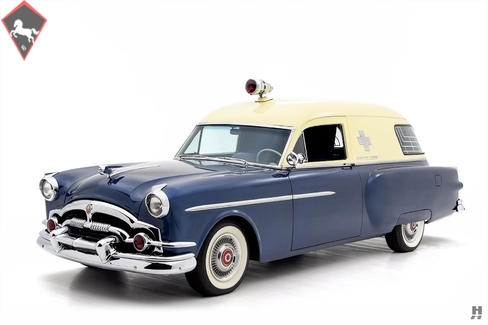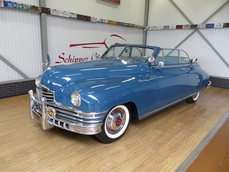Packard Clipper Ambulance 1954
Allgemeine Beschreibung :
The Packard Motor Car Company is one of the most storied names in all of motoring. Collectors the world over covet the great motorcars from Detroit for their beauty, quality, and prestige. Packard motorcars have long symbolized wealth and exquisite taste, and the company is a true American icon. Perhaps less well-known, however, was Packard’s long-running commitment to the commercial and professional vehicle trade. Packard contributed substantially to the development of heavy trucks, building their first in 1902, and producing as many as 6,700 units annually during the height of World War I. However, as heavy truck design became increasingly specialized, Packard bowed-out of the business in 1923 to concentrate wholly on passenger cars.
Even with the shift away from heavy trucks, demand remained for so-called “professional cars.” This category included taxis, hired limousines, funeral cars, ambulances, and other specialty vehicles. Much like with road car production, prestige and quality were driving factors in the professional car business, which Packard offered in spades. Firms such as A.J. Miller Company, Knightstown, and Eureka all favored Packard chassis for their funeral cars and hearses. Among the most esteemed commercial coachbuilders was John W. Henney & Company of Cedarville, Illinois. Henney built the world’s first motorized hearse in 1916, and their hand-carved ambulances and hearses were beautifully crafted. Like Packard, Henney built their vehicles up to a standard, rather than down to a price. This shared philosophy would lead Henney to secure an exclusive deal with Packard, much to the annoyance of competitors such as Hess & Eisenhardt. Period advertising touted “The Body is Henney – The Chassis is Packard – The Combination is Exclusive.” The two companies forged a close working relationship, which until Henney’s demise due to mismanagement in 1955.
Featured here is an intriguing 1954 Packard Series 5433 Clipper, outfitted from new by Henney as a Junior short-wheelbase ambulance. Built in the final year of production, this is one of Henney’s rare Junior models, built on the shorter chassis and touted for its performance and maneuverability. This model was favored by the US Military, and it is believed, based on information from the previous owner that this one served on an Air Force base in period. It is a lovely and enjoyable car, with a good quality cosmetic restoration finished in an attractive two-tone scheme of metallic blue with a cream roof. Important original fittings remain intact, including the original light/siren assembly and the stylized chrome crosses, which were a trademark of Henney Ambulances at the time. The body is in very good condition, with high-quality paint and detailing. The extensive chrome plating presents well, with much of it restored to a good standard, mixed with a few finely-preserved original pieces. The presentation is strong, making a bold statement – even without the siren!
The interior is trimmed in complementary blue and off-white upholstery, and it presents in excellent condition. A split bench seat features up front, while a single jump-seat unfolds from the right rear floor. The rear compartment is covered in period-appropriate linoleum flooring. Original equipment includes a rear heater, built-in first aid cabinet, privacy curtains and metal safety bars in quarter windows. The quality of the upholstery and detailing is quite good, again with a mix of restored and excellent original pieces comprising the dash and interior fittings. The odometer shows just over 67,000 miles which may be authentic, considering this car’s relatively easy service life on an air force base.
The Clipper’s 288 cubic-inch inline eight is a proven, robust, and bulletproof design that was well-suited to emergency-services. This example runs exceptionally well, benefitting from meticulous care and sorting by its previous owner, a dedicated Packard enthusiast and collector. The underhood presentation is very good, with features such as an original oil-bath air cleaner and Willard battery lending an authentic feel. The well-sorted, strong-running nature encourages regular use on the road, and it would be a welcome and unique participant on Packard Club or Professional Car Club events. Henney produced just 120 commercial-bodied Clippers in 1954, and it is unknown exactly how many left the plant as Junior-series Ambulances. Survivors are very scarce, particularly those with their original features intact. This wonderful Henney is a rare and fascinating collector piece that would be equally at home in a collection of military or vintage commercial vehicles as it would be in any Packard collection.
https://hymanltd.com/vehicles/6310
1954 Packard Clipper Ambulance is listed verkauft on ClassicDigest in St. Louis by Mark Hyman for $49500.
Fakten der Auto
Karosserietyp : Auto Marke : Packard Modell : Clipper Ausführung : Ambulance Hubraum : 0.0 Modelljahr : 1954 Lage : Missouri
Verkauft
Angaben Zum Verkäufer
Verkauft
People who viewed this Packard Clipper also viewed similar Packard listed at ClassicDigest
Other cars listed for sale by this dealer
über Packard
Packard: Eine umfassende GeschichteFrühe Jahre und Stiftung:
Gründung: Die Packard Motor Car Company wurde 1899 in Warren, Ohio, von James Ward Packard, William Doud Packard und George Lewis Weiss gegründet.
Pionierluxus: Packard produzierte zunächst hochwertige Automobile und wurde zum Synonym für Luxus, Handwerk und technische Exzellenz.
Bemerkenswerte Erfolge und Beiträge:
Packard Twin Six: Das 1916 eingeführte Auto wurde Packard als Premier Luxury Automobile Marke eingerichtet.
Modelllinienerweiterung: Packard hat seine Aufstellung mit verschiedenen Modellen erweitert, darunter Limousinen, Coupes, Cabrios und Limousinen, die an wohlhabende Kunden geliefert werden, die Eleganz und Leistung suchen.
Engineering Innovations: Die Marke führte mehrere Innovationen ein, z.
Zehn historisch bedeutende Modelle mit technischen Spezifikationen:
Packard Twin Six (1916):
Motor: 7.3L V12 Motor.
Leistung: rund 85 PS.
Packard acht (1930-1938):
Motor: Straight-8 Motor mit verschiedenen Verschiebungen.
Leistung: reicht zwischen 90 und über 130 PS.
Packard Super Eight (1939-1951):
Motor: Straight-8 Motor.
Leistung: Produktion zwischen 130 und 180 PS.
Packard One-Twenty (1935-1942):
Motor: Straight-8 Motor.
Leistung: ca. 100 bis 120 PS.
Packard Clipper (1941-1957):
Motor: V8 Motor.
Leistung: reichen von 135 bis 185 PS.
Packard Caribbean (1953-1956):
Motor: V8 Motor.
Leistung: variiert zwischen 275 und 310 PS.
Packard Patrician (1951-1956):
Motor: Inline-8- und V8-Motoren.
Leistung: reicht von 150 bis 180 PS.
Packard Hawk (1958):
Motor: V8 Motor.
Leistung: Erzeugt um 275 PS.
Packard Executive (1956-1958):
Motor: V8 Motor.
Leistung: variiert zwischen 240 und 290 PS.
Packard Predictor (1956):
Motor: Konzeptauto präsentieren Design und Technologie.
Leistung: Prototypmodell.
Vermächtnis und Einfluss:
Qualität und Eleganz: Packard wurde wegen seiner außergewöhnlichen Verarbeitungsqualität, des raffinierten Stylings und seiner Luxusmerkmale verehrt, die häufig mit europäischen Luxusmarken wie Mercedes-Benz auf A-A-Niveau berücksichtigt wurden.
Produktionsende: Die Marke hatte in den 1950er Jahren finanzielle Kämpfe, was zu ihrer Fusion mit Studebaker und letztendlich Ende der 1950er Jahre führte, was das Ende einer Ära in amerikanischen Luxusautomobilen kennzeichnete.
Packard hinterließ ein dauerhaftes Erbe in der Automobilindustrie, symbolisierte Eleganz, technische Exzellenz und ein Engagement für Luxus, das weltweit von Autoenthusiasten bewundert und respektiert wurde.









